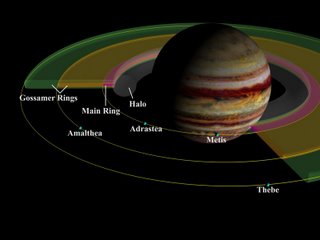Jupiter's atmosphere is composed of ~81% hydrogen and ~18% helium by number of atoms. The atmosphere is ~75%/24% by mass; with ~1% of the mass accounted for by other substances - the interior contains denser materials such that the distribution is ~71%/24%/5%. The atmosphere contains trace amounts of methane, water vapour, ammonia, and "rock". There are also traces of carbon, ethane, hydrogen sulfide, neon, oxygen, phosphine, and sulfur. The outermost layer of the atmosphere contains crystals of frozen ammonia.
This atmospheric composition is very close to the composition of the solar nebula. Saturn has a similar composition, but Uranus and Neptune have much less hydrogen and helium.
Jupiter's upper atmosphere undergoes differential rotation, an effect first noticed by Giovanni Cassini (1690). The rotation of Jupiter's polar atmosphere is ~5 minutes longer than that of the equatorial atmosphere. In addition, bands of clouds of different latitudes, known as tropical regions flow in opposing directions on the prevailing winds. The interactions of these conflicting circulation patterns cause storms and turbulence. Wind speeds of 600 km/h are not uncommon. A particularly violent storm, about three times Earth's diameter, is known as the Great Red Spot, and has persisted through more than three centuries of human observation.
The only spacecraft to have descended into Jupiter's atmosphere to take scientific measurements is the Galileo probe. It sent an atmospheric probe into Jupiter upon arrival in 1995, then itself entered Jupiter's atmosphere and burned up in 2003.

